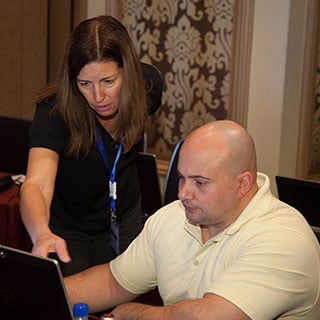BPC Administration Training: 10.1 Microsoft
Course Description / Summary:
This course includes in-depth instruction on primary tasks of an administrator of SAP BPC. In this course you will explore creating and running data manager packages and managing environments, models, and dimensions. You will also discover how to secure dimensions and how to provide users with specific tasks and data profiles. You will also learn how to streamline business processes by creating process templates and managing Business Process Flows, and much more!
Audience:
- BPC Administrators
- BPC Power Users
Prerequisites:
- Experience using Microsoft Excel
- Familiarity with modeling concepts and data warehousing
Courses:
- BPC Metadata
- Data Manager packages
- Security and Work Status
- Journals and BPC Web Client
- Publication and Distribution
- Process Flows (BPFs)
Read MoreRead Less
Timing:
- BPC Application Administration (Microsoft) is comprised of seven, 3-hour courses, which may be taken alone or in series. These courses should be taken as early in the implementation as possible.
Product Hands-On:
- Virtual Classroom Training: Interactive simulation exercises to provide hands-on experience with BPC
- On-Demand eLearning: Interactive simulation exercises to provide hands-on experience with BPC
- On-Site Classroom: Exercises performed in your BPC environment
Training Curriculum:
- Presentation, instructor demonstrations, and exercises use the Column5 Training environment.
- BPC 10.1 Microsoft Administration Learning Objectives
- Metadata
- Identify the process for creating new environments
- Identify the process for deleting environments from the server
- Recognize the method for modifying environment parameters
- Identify the steps and rules for adding new dimensions to environments
- Differentiate between dimension types
- Recognize the process for managing dimension hierarchies
- Recognize the process for storing data by creating new models
- Distinguish between Model types
- Identify the method for managing model properties
- Recognize how to optimize data by utilizing storage and process types
- Data Manager
- Recognize the location and uses of Data Manager
- Identify how packages are organized
- Identify the file type used to represent packages
- Recognize the order of the standard five steps of the Package Cycle
- Identify how prompts are used
- Identify the process for executing Data Manager Packages
- Identify the steps for using a Data Manager Package to clear data from within a model
- Recognize the method for utilizing package comments
- Identify the steps for using a Data Manager Package to copy data between dimensions
- Identify the steps for using a Data Manager Package to export data from a model
- Identify the steps for using a Data Manager Package to import data into a model
- Recognize the process for organizing packages
- Identify the process for customizing an existing package
- Journals and Web Client
- Recognize the steps for creating a new journal template
- Differentiate between Translation Table Columns
- Identify the process for implementing Journal Reopen Rules
- Recognize the method for administering journals
- Recognize the process for restricting dimension members
- Identify the process for implementing journal security
- Identify the correct method for adjusting existing journal entries
- Identify the method for deleting journals
- Identify the method for creating, saving, posting, and un-posting journal entries
- Recognize the location to access Planning and Consolidation objects using the Web Client
- Identify the method for formatting a Report
- Recognize the steps for adding new Objects to the Library
- Identify the location and uses for Activities, the Process Monitor, and the Library
- Differentiate between the uses of Objects, Processes and Documents
- Recognize the steps for utilizing the Web Client to prepare reports on system information
- Recognize the steps in creating an Advanced Variance Analysis
- Security and Work Status
- Differentiate between the different ways user access can be managed by configuring security components
- Identify the steps for adding new user accounts
- Identify the steps for modifying user properties
- Identify the steps for assigning users to teams
- Identify the steps for creating Team Leaders
- Recognize the steps for assigning team access to Task Profiles and Data Access Profiles
- Identify the methods for creating, modifying, and deleting Task Profiles
- Recognize the process for granting users access in a Data Access Profile
- Identify the process for configuring a Data Access Profile
- Recognize the steps for securing dimensions, as well as the results
- Identify the purpose for creating the Owner dimension
- Identify the process for modifying the work status settings
- Recognize the steps for configuring work status message and environment parameters
- Recognize the process for generating a work status report
- Publication and Distribution
- Identify the steps to take to produce a report using the EPM Pane
- Differentiate between Portal Publication and Book Publication
- Identify the correct steps for creating a book template
- Identify the process for modifying the properties of a book
- Differentiate between the three Dimension selector types
- Recognize how to select dimensions using the Dimension Selector
- Identify the steps for saving a book template
- Recognize the steps involved in publishing a book of reports
- Identify the correct method for creating a distribution template
- Identify the purpose and process for performing validation on a template
- Recognize the steps involved in distributing and collecting reports and input forms
- Identify the correct steps for utilizing the EPM Add-in for Word and PowerPoint to create BPC Reports
- Processes and Audit
- Identify the steps for using a process to run a sequence of application tasks
- Differentiate between process templates and process instances
- Identify the method for creating a process template
- Identify required dimensions and properties when creating processes
- Recognize the steps for using the process context to set dimensions
- Identify the steps for setting access to a process template
- Recognize the process for using steps to define tasks
- Identify the process for reordering, modifying and deleting steps and sub-steps
- Recognize the process for defining step or sub-step options
- Identify the process for defining specific tasks by creating actions
- Differentiate between process statuses
- Recognize the steps to launch a process
- Identify the method for managing process templates
- Recognize the process for enabling or disabling data auditing and activity auditing
- Identify the method for generating audit reports
- Intro to Logic
- Recognize when to use different types of logic when executing calculations
- Name the steps for creating and executing worksheet calculations
- Recognize the purpose and method for adding the FORMULA property to a dimension
- Identify the steps for assigning dimension logic to a member
- Identify the method for utilizing Script Logic to perform calculations for special requirements
- Recognize the steps for performing complex allocations using the Allocation engine
- Recognize the process and purpose for supporting accounting activities using Business Rules
Take Away Training Materials:
- PDF of presentation
Software:
- SAP Planning and Consolidation 10.1 for Microsoft
Advanced Preparation:
- None
CPE Credits for Onsite Training (Group Live) and Virtual Classroom (Group Internet Based):
- 5 CPE credits per course.









